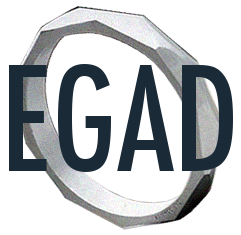Terms and Examples
Alignment: Alignment in the curriculum occurs when learning materials, instructional methods and assessment all support attainment of the stated learning outcomes/indicators.
Assessment tool: The means by which data on student learning is collected.
Example: design report, presentation, essay, examination, standardized exam, oral exam, observed behavior, focus group, survey, etc.
Authentic assessment: Methods that examine a student's ability to solve problems or perform tasks that closely resemble real-world situations.
Continuous Curriculum Improvement Process: An iterative process of review that enables ready identification of strengths, limitations, gaps and redundancies within a program.
Curriculum map: a plotted representation of the learning experiences (e.g. courses, co-ops, cocurricular activities), instructional and assessment methods, and intended learning for each aspect of a given program so that the relationships and connections among all the elements are easily seen.
Example, Graduate Attribute Focus: If a program identified three indicators to demonstrate the graduate attribute Lifelong Learning, as described above, a curriculum map showing how that attribute is developed and assessed might look like the table below. The Developed column describes learning experiences (e.g. courses, co-ops, etc.) where students develop knowledge, skills, or behaviors. The Assessed column describes learning experiences where the indicator is assessed.
Direct evidence: Direct evidence of learning are observable or measurable assessments of student learning.
Finding: The facts, the data, the empirical results
Example: Forty-two percent of students currently meet threshold levels demonstrating the Lifelong Learning Graduate Attribute.
Gaps: Curricular gaps occur when the logical progression between courses, knowledge and skill development is broken or when students' prior learning in a program is insufficient to prepare them for the next expected course of study.
Graduate Attributes: generic characteristics, specified by the CEAB, expected to be exhibited by graduates of Canadian engineering schools.
- Knowledge Base
- Problem Analysis
- Investigation
- Design
- Use of engineering tools
- Team work
- Communication
- Professionalism
- Impact on Society and Environment
- Ethics and equity
- Economics and Project Management
- Life-long learning
Indicators: descriptors of what students must do to be considered competent in an attribute; the measurable and predetermined standards used to evaluate learning.
Example: Criterion 3.1.12 requires that students possess the attribute Lifelong Learning. A program might consider that the indicators required to demonstrate that students possess this attribute include:
- Critically evaluates procured information for authority, currency, and objectivity.
- Describes professional and academic societies in the discipline and how new knowledge enters discipline.
- Identifies resources and professional associations that address own ongoing professional development.
Indirect evidence: Opinions or self-reports of student learning or educational experiences.
Interpretation: An explanation offered about the findings; speculations about interrelationships, causes and reasons; meanings given to the data.
Example: Lack of opportunities for student self-assessment and self-regulated learning have resulted in only 42% of students reaching threshold levels in Lifelong Learning.
Judgment: Values brought to bear on the data; specific criteria applied to the findings that indicate whether they are good, bad, positive or negative.
Example: Only forty-two percent of students currently meet threshold levels demonstrating the Lifelong Learning Graduate Attribute
Mapping: A plotted representation of the learning experiences (e.g. courses, co-ops, cocurricular activities), instructional and assessment methods, and intended learning for each aspect of a given program so that the relationships and connections among all the elements are easily seen.
Misalignment: in the curriculum occurs when any one element (learning materials, instructional strategies, or assessment strategies) is incongruent with expectations for students' learning.
Outcomes-based: Different from inputs-based processes that focus on what institutions put into their programs, outcomes-based review processes focus on what students get out of them. In the instance of Canadian engineering schools, the outcomes against which programs will be reviewed, for accreditation purposes, are the Engineering Graduate Attributes that have been defined by CEAB.
Overlap: Overlaps occur when concepts or skills are introduced, taught or utilized in more than one area of the program. Overlaps are beneficial to students' learning when they are purposefully constructed opportunities to revisit concepts and skills in more depth and greater levels of complexity.
Performance Target: the intended level of learning proficiency on a given assignment or at the conclusion of a course or program.
Recommendation: Suggested courses of action; proposed changes or areas to be maintained and suggestions/advice on how to improve
Example: Since only 42% of students are reaching threshold levels in Lifelong Learning, more opportunities for self-assessment and action-planning should be created.
Redundancies: Redundancies occur when concepts and skills are covered in multiple places in the curriculum to no obvious benefit to students' learning.
Rubric: a scoring guide, usually in chart form, that outlines explicit sets of criteria at progressive levels of learning performance; used for grading as well as for planning instruction and learning.
Target: The intended level of learning proficiency on a given assignment or at the conclusion of a course or program.
Threshold: The minimum acceptable level of proficiency for success on a given assignment, course, or program.
